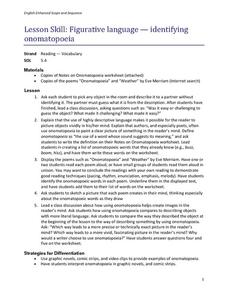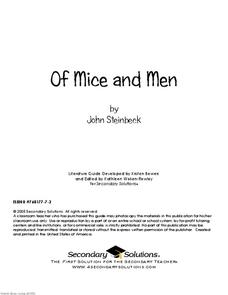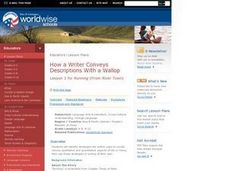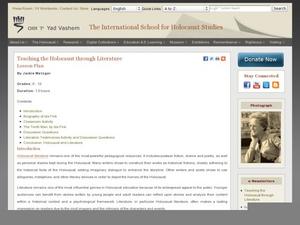EngageNY
Continued Close Reading of Bullfrog at Magnolia Circle: Text-Dependent Questions and Vivid Words and Phrases
As 3rd graders continue reading Bullfrog at Magnolia Circle, they focus on the concepts of predator and prey in the fifth lesson plan of this unit. Scholars further develop their ability to answer questions using evidence from the text...
EngageNY
Continued Close Reading of Bullfrog at Magnolia Circle: Text-Dependent Questions and Vivid Words and Phrases
In the third activity from this unit based on the book Bullfrog at Magnolia Circle, learners focus on using specific details from the text-to-answer questions about the habitat of bullfrogs. While reading the text, young scholars are...
Curated OER
Capturing the Reader With Vivid Images
Students examine the use of imagery to hold a reader's attention in an excerpt from John Deever's memoir "Mr. John and the Day of Knowledge". They are introduced to background information about the Ukraine and create original imagery.
EngageNY
Writing to Show, Not Tell: Dialogue, Sensory Words, and Strong Action Verbs
Consume, gobble, devour ... serving up strong verbs! Writers focus on using dialogue, strong action verbs, and sensory details in their writing. After analyzing a model narrative, they apply their learning to their own hero's journey...
Curated OER
Lesson: Patience, Practice and Persistence
First the class analyzes the painting, Rodeo-Pickup Man by Frank Mechau, then they get to work. They explore the painting through verbal descriptions, focusing on vivid language to describe detail. They then compose a written piece using...
Curated OER
Agriculture Awareness Through Poetry
Whether you are viewing a landscape painting of a farm, examining a still-life portrait of a bowl of fruit, or reading a descriptive poem about cultivating food, you can't deny that agriculture plays a major role in visual and language...
Curated OER
Figurative Language- Identifying Onomatopoeia
A study of onomatopoeia for 5th graders is here for you. Pupils discover that the use of highly descriptive language makes it possible for readers to picture objects in their minds. After engaging in a class discussion and listening to...
Curated OER
Lesson: Mad Lib Leigh!
A fun and quirky painting is analyzed for details in an art/literacy lesson plan. Youngsters look for colors, shadows, and details and then describe them using vivid language. They use the words from discussion to complete a fun Mad...
Curated OER
Lesson: Paint Inspiring Words
The painting Three Young Girls circa 1620, was believed to be painted after the death of the subjects' mother. Art enthusiasts analyze the image details to determine if they come to the same conclusion. They then use the sensory details...
Curated OER
Narrative Writing
Fifth graders study narrative writing. In this language arts lesson, 5th graders review how an author uses vivid verbs, imagery, and adjectives to capture reader's attention. Students explore literary devices of foreshadowing, flashback...
National Endowment for the Humanities
Vengeful Verbs in Shakespeare’s “Hamlet”
It's time for pupils to read, examine, and contemplate literature to explore the difference between vivid and generic verbs. Pupils distinguish between the two types of verbs as they read the ghost scene from Shakespeare's Hamlet. They...
Macmillan Education
Understanding Poetry
William Wordsworth's "Daffodils" provides young poets with an opportunity to examine how a poet can use powerful images and poetic devices to create vivid pictures in the minds of readers.
Secondary Solutions
Of Mice and Men: A Literature Guide
Whether you are planning on using Of Mice and Men for whole-class reading or as a selection for literature circles; whether you are new to John Steinbeck's novel, or it has long been a part of your curriculum, you will find a wealth of...
Curated OER
Amos and Boris: Text Study
Twenty insightful questions follow a read aloud of the story, Amos and Boris by William Steig. Scholars then show what they know through completion of a cause and effect chart, reading fluency assessment, and a written explanatory or...
Scholastic
Hold the Presses!: Revising for Connotation
Middle schoolers discuss the meaning of the sentence, The student asked to go to the office." Ask the class if the sentence gives the reader any information about the student. Can they visualize the way the student asked the question?...
Southern Nevada Regional Professional Development Program
“Tell Me a Story”: Moving from Reading to Writing
Narrative essay writing is the focus of a series of exercises that model for learners how to not only read a narrative, but how to also examine the techniques fiction writers use to create a setting, develop their characters, represent...
Curated OER
How a Writer Conveys Descriptions With a Wallop Lesson 3 for Running (From River Town)
Students examine strategies an author uses to provide qualitative and quantitative aspects of life in China. They apply the strategies to their own writing.
Curated OER
Imagining China through Words
When Europeans first came back with tales of China, they provided vivid written accounts and minimal visual imput. This resulted in art rendered mostly from descriptive language. Learners explore this phenomena by listening to...
Curated OER
Carl Sandburg's "Chicago": Bringing a Great City Alive
Carl Sandburg composed poetry that conveyed a time and place in American Literature and history. Learners identify the literary techniques he uses to describe the historical and cultural context of living in Chicago. They define the...
Curated OER
Teaching the Holocaust through Literature
Centered on the short story "The Tenth Man" by Polish Holocaust survivor Ida Fink, here is a solid one-day resource to support study of World War II or Nazi history, short stories, or to complement any ELA unit on The Diary of Anne Frank...
Curated OER
How Do Adjectives Improve Writing?
Using adjectives to create vivid descriptions is the focus of exercises in this resource. A cloze reading activity asks class members to add missing adjectives to passages from Mark Teague's The Lost and Found. They then read Teague's...
Bolton Healthy Schools
Deal with Poetry
The stated goal of this unit is to use poetry to "improve the emotional health of young people." Budding poets read and then supply their own lines for poems that deal with alienation, loneliness, and rejection.
Curated OER
Carl Sandburg's "Chicago": Bringing a Great City Alive
Students examine the historical and cultural context in Sandburg's poem. The poetic devices of personification and apostrophe are utilized in the poem and identified by Students.
Curated OER
Nonfiction Genre Mini-Unit: Persuasive Writing
Should primary graders have their own computers? Should animals be kept in captivity? Young writers learn how to develop and support a claim in this short unit on persuasive writing.

























